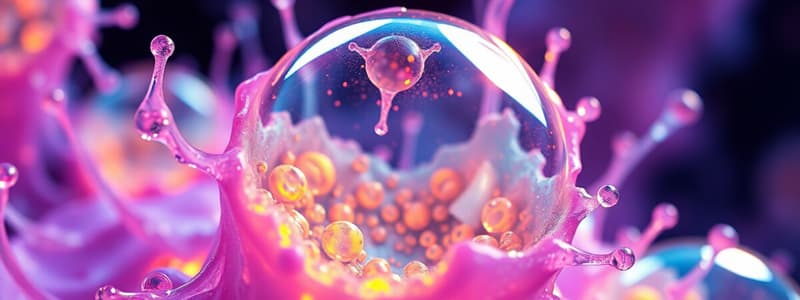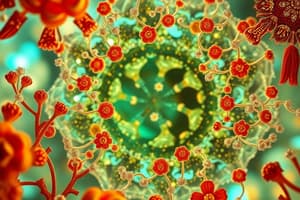Podcast
Questions and Answers
A researcher needs to observe the dynamic movement of organelles within a living cell. Which type of microscope would be most suitable for this purpose?
A researcher needs to observe the dynamic movement of organelles within a living cell. Which type of microscope would be most suitable for this purpose?
- Phase-contrast microscope (correct)
- Dark-field microscope
- Bright-field microscope
- Fluorescence microscope
A pathologist wants to examine a tissue sample with fluorescently labeled antibodies to identify a specific protein. Which type of microscope is best suited for this purpose?
A pathologist wants to examine a tissue sample with fluorescently labeled antibodies to identify a specific protein. Which type of microscope is best suited for this purpose?
- Dark-field microscope
- Phase-contrast microscope
- Fluorescence microscope (correct)
- Bright-field microscope
A microbiologist is studying a live bacterial culture to observe its natural behavior without altering its structure. Which microscopic technique would be most appropriate?
A microbiologist is studying a live bacterial culture to observe its natural behavior without altering its structure. Which microscopic technique would be most appropriate?
- Dark-field microscopy (correct)
- Bright-field microscopy with staining
- Phase-contrast microscopy
- Confocal microscopy with electronic staining
If an ocular lens has a magnification of ×15 and the objective lens being used has a magnification of ×60, what is the final magnification of the image being observed?
If an ocular lens has a magnification of ×15 and the objective lens being used has a magnification of ×60, what is the final magnification of the image being observed?
A researcher is examining a thick tissue sample and needs to obtain a series of high-resolution images at different depths within the sample. Which type of microscope would be most suitable?
A researcher is examining a thick tissue sample and needs to obtain a series of high-resolution images at different depths within the sample. Which type of microscope would be most suitable?
Which of the following is a primary limitation of using a bright-field microscope for visualizing specimens?
Which of the following is a primary limitation of using a bright-field microscope for visualizing specimens?
Flashcards
Light Microscope
Light Microscope
Uses visible light and lenses to magnify images.
Ocular Lens
Ocular Lens
The lens you look through, usually magnifies 10x.
Objective Lens
Objective Lens
The lens closest to the specimen.
Bright-field Microscope
Bright-field Microscope
Signup and view all the flashcards
Dark-field Microscope
Dark-field Microscope
Signup and view all the flashcards
Phase-Contrast Microscope
Phase-Contrast Microscope
Signup and view all the flashcards
Study Notes
- Light microscopes use visible light for observation.
- Total magnification is calculated by multiplying the power of the ocular and objective lenses; for example, a 10x ocular lens with a 4x objective lens yields 40x total magnification.
Bright-field Microscope
- Requires fixing and staining the specimen.
- The background appears lighter than the specimen.
Dark-field Microscope
- Used for viewing live, unfixed, and unstained specimens.
- The background is dark, while the specimen appears bright.
Phase-Contrast Microscope
- Allows for viewing transparent, unfixed specimens.
- Useful for observing cell division, motility, and organelle dynamics.
Fluorescence Microscopes
- Used to visualize specimens containing naturally fluorescent substances or those stained with fluorescent dyes.
Confocal Microscopes
- Produces sharper images compared to traditional microscopes.
- Allows visualization of different planes within a specimen.
- Enables three-dimensional display with electronic staining.
Studying That Suits You
Use AI to generate personalized quizzes and flashcards to suit your learning preferences.




